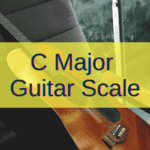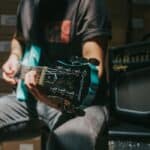Have you ever wondered what would happen if you put some flip-flops on a jazz musician and force him or her to play with their toes in the sand?
Moreover, what would the effect of the happy, easygoing Brazilian beach lifestyle be on such a traditional music style?
Well, the answer is ubiquitous: Bossa Nova.
If you’re not familiar with this groundbreaking musical style that flourished in the ’50s in Brazil and that has taken over the world, worry not because this is an in-depth guide that will have you playing Bossa Nova in no time.
Get on your shorts because it’s Ipanema time!
A Little Story – Garota do Ipanema
Do you know what Sepultura, Cher, Sammy Davis Jr., Madonna, Frank Sinatra, Ella Fitzgerald, Diana Krall, The Supremes, and Shirley Bassey have in common?
They all played live and/or recorded their own version of this timeless classic.
“Garota do Ipanema” (Girl of Ipanema) is a song that has become the global ambassador of this kind of Samba that borrows from jazz in its complexity but follows the samba beat to get people dancing.
Furthermore, “Garota do Ipanema” was such a staggering success upon release that it made it to Hollywood being part of the soundtrack in movies such as The Fabulous Baker Boys, Wayne’s World 2, Catch Me if You Can, Mr. and Mrs. Smith, V for Vendetta, and many more.
Bossa Nova is a big part of world music and also a great flavor to include in any of your compositions and spice them up with some Latin flavor.
Key Elements of a Bossa Nova Song
Now that you know of Bossa Nova’s relevance in the music world, let’s talk about the elements that define the style.
Clave or Samba Rhythm Pattern
Bossa Nova is a Latin rhythm, and as such, it requires that particular beat that will get people dancing.
In this case, locals call it “clave” and you can easily identify it as the Bossa Nova beat or groove.
Fingerstyle Guitar Playing
Bossa Nova players use their thumb to play the bass notes and the rest of the fingers to play the melody just like some Americana, Country, and Hillbilly players do.
The main difference is that in Bossa Nova, the approach is always going for a soft pattern without strumming or arpeggiating; just playing several strings at the same time.
Nylon Strings
To achieve the right Bossa tone it’s paramount that you play a nylon-string guitar.
Metallic strings are just too bright for this music style and don’t convey the same intimate, loving feeling.
2/4 Time Signature
Another big part of Bossa is the syncopated feel. This is often achieved by playing the musical pieces in 2/4 instead of the standard 4/4. Nevertheless, you can play Bossa in 4/4.
We’ll be Playing These Chords
Although the rhythmic side of guitar playing is of ultimate importance for Bossa Nova, playing the right chords is just as important. So, we’re going to go over the chord types we’ll be using in our progressions.
- 7th chords – These chords, made of four notes instead of three are very common in many musical styles including blues and jazz. They are made by adding the seventh degree of the scale to the triad. For example, C-E-G is C major; C-E-G-B is Cmaj7.
- Minor 9th chords – Just like a 7th chord requires the addition of the seventh grade of the scale, a 9th chord requires the addition of the ninth degree. In this case, it’s a minor 9th, so an example using the C minor chord, C-Eb-G, would be C-Eb-G-D.
- Slash Chords – Slash chords are amazing for transitions because they use the bass note of one chord over the structure of another. This is not-so-common in popular music but it’s almost a must or a trademark in Bossa Nova.
- Suspended Chords – Suspended chords are, by definition neither major nor minor. Indeed, since the third is replaced by the second (sus2) or the fourth (sus4), they omit being defined like that by the third. In Bossa Nova they make the perfect transition from minor to major and vice versa.
11 Bossa Nova Chord Progressions
Now that we’ve gone through the preliminary phase and explained all the important concepts, it’s time we address the elephant in the room and go for the chord progressions.
Buckle up!
1. The II – V – I Progression
I know what you’re thinking, but I’m going to stop you right there!
This is a famous jazz progression known as the 251 and you’ve seen and probably played it a million times but here it has a different flavor.
Yes, the main aspect of guitar playing when you’re a Bossa master is the rhythm your picking hand can give the tune (remember the 2/4).
What you have to respect and play properly is the accents that can make your feet and your head move to the music you’re playing.
In this sense, Bossa is not at all a hard rhythm to play, you just have to pay attention to the syncopation with the beat.
Let’s try a very simple II – V – I in C major: Dm – G – C
You can also transform all those chords into seventh chords and have even more fun, it would be Dm7 – G7 – C7.
Here’s a cool backing track to play along with so you can practice accents.
2. The Imaj7 – II7 – iim7 Progression
This is the famous chord progression used in “Garota do Ipanema”. This is one of those strange cases in which we come across the same chord being played as a major and as a minor.
As you’ll see when you start playing it, the way the chord transforms changes the entire flavor or mood of the tune and turns it into something else.
If we were to apply this to our C major scale, we’d get a Cmaj7 – D7 – Dm7.
You can try it with this backing track to see how it feels.
3. The I – VI – II – V Progression
This chord progression is also known as “The Jobim Chord Progression”. Antonio Jobim is the father of Bossa Nova.
As you’ll see, this progression is a tad more complex since it adds a new chord, but in essence, your job playing this progression is the same; respect the rhythm and play the chords with your fingers.
If we pour the key of D major into this progression, what we get is:
Or, for more pleasure, you can always play D7 – Bm7 – Em7 – A7.
Here’s a backing track so you can taste the way it sounds on a D major scale.
4. The I – VII – III – VI – II – V – I Progression
Workout video: https://youtu.be/f_jz9V0f5aA
5. The IVMaj7 – iim7 – Imaj7 – V7 – IV – IVMaj7 – V7 – IMaj7 Progression
6. The I – V7 – IIm7 – V7 – I Progression
7. The I – VIb7 – IIm7 – V7 – I Progression
8. The I – V7 – IIbmaj7 – I Progression
9. The IIm7 – V7 – VIm7 Progression
10. The IIm7 – V7 – VIbmaj7 Progression
11. The IIm7 – V7 – IIbmaj7 Progression
The Bottom End
As you’ve seen, Bossa Nova is the ultimate mix between a dancing rhythm and a jazz suite. Moreover, it is the ultimate “nerds having fun” kind of approach to music.
Once you learn to master it, it will broaden your musical horizons drastically while making you dance on the spot.
Before I let you go to rip that nylon-string guitar, let me give you a last piece of advice: don’t overlook your picking hand.
Keeping up with the rhythmic part is just as important as playing the chords right.
As a personal bit of help, here’s a little insight on how to play that magical “Garota do Ipanema” rhythmic beat with your guitar.
Make sure you copy it well enough to change it completely and make it your own.
Happy (nylon string) playing!

Hello there, my name is Ramiro and I’ve been playing guitar for almost 20 years. I’m obsessed with everything gear-related and I thought it might be worth sharing it. From guitars, pedals, amps, and synths to studio gear and production tips, I hope you find what I post here useful, and I’ll try my best to keep it entertaining also.





